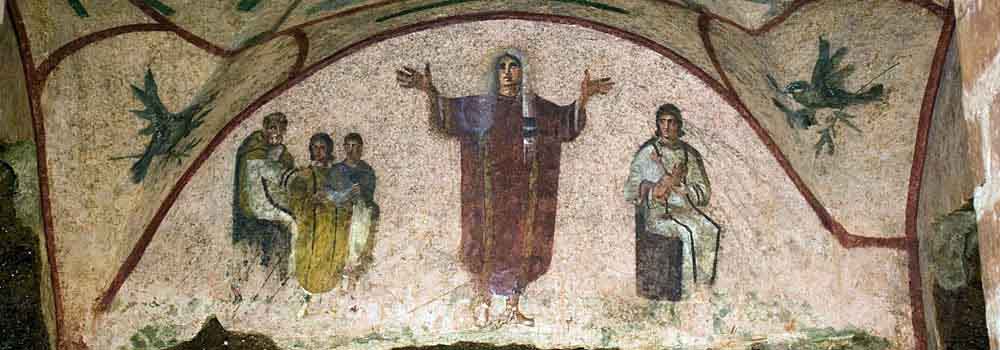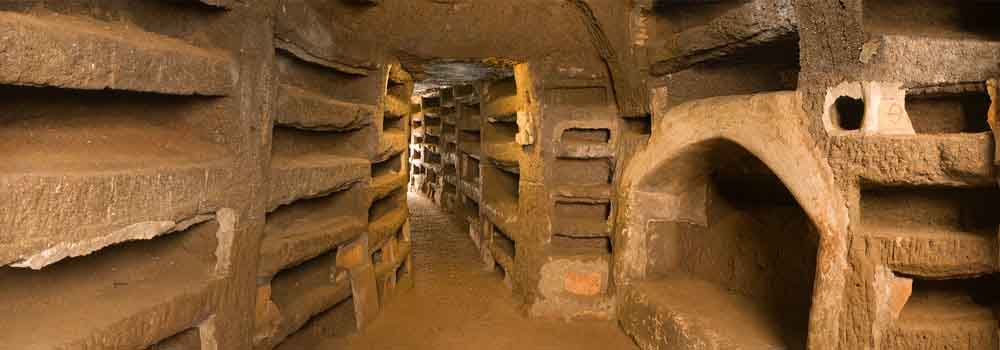The Catacombs of Priscilla are an ancient Christian burial site located on Via Salaria above Villa Ada Park in northern part of Rome. Sometimes called the “Queen of Catacombs,” these catacombs measure an impressive five miles and date back to at least the 2nd century. Although these aren’t as famous as the Catacomb of Callixtus or the Catacombs of San Sebastiano, the Catacombs of Priscilla are extremely important to scholars because they are home to some of the earliest known Christian frescoes.

Many historians believe that these catacombs got their name from a noblewoman in the wealthy Acilii Glabrioni family. The story goes that this woman was a devoted Christian who donated her land as a burial site for early Christians as well as family members. The catacombs were most likely used between the 2nd and 4th centuries before they were abandoned. It wasn’t until the 15th century that Romans rediscovered these intricately designed catacombs. Archeologists believe that there were approximately 40,000 tombs within these narrow catacombs.
One of the major reasons that these catacombs are so well known has to do with their incredible religious frescoes. Arguably the most important frescoes in this complex are in an area known as the Greek Chapel. Although some of the frescoes are a bit faded, guests walking around this square chamber can still appreciate artistic depictions of famous scenes from the Old and New Testament. Of particular importance is a depiction of the Virgin Mary with Child, the first known Madonna With Child in the Christian tradition. A few other central scenes that still survive in these catacombs include the Final Judgment, Abraham about to sacrifice Isaac, and Jesus as the Good Shepard. In case you were wondering, the only other location on earth with Christian art that dates back to the 3rd century Dura-Europos in Al-Salihiyah, Syria.
Rome Catacombs Night Tour | Small Group | VIP Access After Closing
Saturdays at 5.15pm 2.5 hours
The main reason there are no bodies in these catacombs today is due to grave robbing. Not all robbers, however, were interested in hording worldly treasures. Since Christian martyrs were buried here, many early Christians went to these catacombs to collect relics from people who died for their faith. In the Ancient and Medieval world, many Christians believed the bones of martyrs possessed supernatural powers. Today, the relics of saints and martyrs continue to inspire Christians around the world to make a firm commitment to their faith, even in the face of death.

In addition to martyrs, these catacombs once housed the remains of least seven early popes such as Pope Marcellus I and Pope Marcellinus. This is one of the two major reasons these catacombs have earned the title the “Queen of Catacombs.” The other key reason for this nickname has to do with a prominent fresco in a chapel called the Cubiculum of the Veiled Woman. This chapel is so named because it has three depictions of what scholars believe to be one woman. The picture on the left shows the woman getting married, the one on the right shows the woman nursing a child, and the third show the woman with arms outstretched and a veil over her head. Although we don’t know who this woman was, it’s most likely that this chapel was her place of burial and the paintings symbolize both her earthly life and her ascension into heaven.
The Catacombs of Priscilla offer an important glimpse into the early history of Christian art. Many of the frescoes depicted throughout the catacombs’ walls would later become the central subjects for the greatest works of Western art. Anyone with an interest in art history can’t pass up a tour of these fascinating chambers on a trip to Rome. The entrance to these catacombs can be found at the Convent of the Benedictine Sisters of Priscilla, which is a 15-minute walk from the Sant’Agnese-Annibaliano Metro stop.


